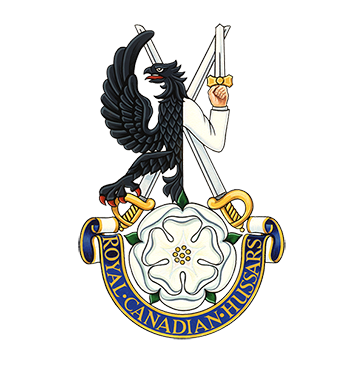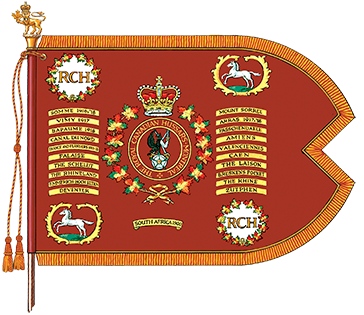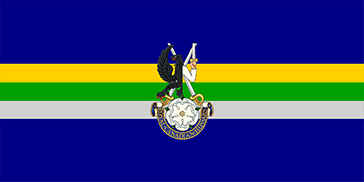The Royal Canadian Hussars (Montreal)
The official lineage of The Royal Canadian Hussars (Montreal) armour regiment.

Badge
Description
A rose Argent barbed Vert seeded Or upon a scroll Azure lined Argent edged and inscribed ROYAL CANADIAN HUSSARS in letters Or all below two swords in saltire points upwards Argent hilted Or surmounted by an eagle displayed Sable armed and langued Gules dimidiated with a sinister arm embowed vested Argent the hand proper holding a dagger palewise Argent hilted Or.
Symbolism
The eagle, sleeved arm with the dagger and the crossed cavalry swords came from the badge of the 6th Duke of Connaught's Royal Canadian Hussars where, originally, the eagle and arm came from the arms of the Irish province of Connaught and the swords represented the cavalry role of the unit. The white rose came from the badge of the 17th Duke of York's Royal Canadian Hussars. It was originally the badge of the Royal House of York. "ROYAL CANADIAN HUSSARS" is a form of the regimental title.
Motto
NON NOBIS SED PATRIÆ (Not for ourselves but for our country)
Marches
St. Patrick's Day; and Men of Harlech
Alliance
British Army
The Queen's Royal Hussars; and The Light Dragoons
Guidon

Camp flag

Battle honours
The War of 1812
DEFENCE OF CANADA – 1812-1815 – DÉFENSE DU CANADA
Honorary Distinction
The non-emblazonable honorary distinction DEFENCE OF CANADA – 1812-1815 – DÉFENSE DU CANADA
South African War
SOUTH AFRICA, 1900.
The First World War
MOUNT SORREL; SOMME, 1916, '18; Flers-Courcelette; Thiepval; ARRAS, 1917, '18; Vimy, 1917; HILL 70; YPRES, 1917; Passchendaele; Baupaume, 1918; Rosières; Avre; AMIENS; Scarpe, 1918; Drocourt-Quéant; HINDENBURG LINE; Canal du Nord; Cambrai, 1918; VALENCIENNES; SAMBRE; FRANCE AND FLANDERS, 1915-18.
The Second World War
CAEN; FALAISE; The Laison; THE SCHELDT; Breskens Pocket; THE RHINELAND; THE RHINE; Emmerich-Hoch Elten; Zutphen; Deventer; NORTH-WEST EUROPE, 1944 1945.
South-West Asia
AFGHANISTAN
Lineage
This Reserve Force regiment originated on 30 November 1877 and incorporates the following regiments.
The Royal Canadian Hussars (Montreal) originated in Cookshire, Quebec on 30 November 1877, when the '5th Provisional Regiment of Cavalry' was authorized to be formed.Footnote 1 It was redesignated: '5th Regiment of Cavalry' on 21 May 1886;Footnote 2 and '5th Dragoons' on 1 January 1893.Footnote 3 On 1 June 1901, it was amalgamated with the '6th "Duke of Connaught's Royal Canadian Hussars"' (see below) and redesignated the '6th Duke of Connaught's Royal Canadian Hussars'.Footnote 4 On 15 December 1936, it was amalgamated with the '1st Armoured Car Regiment' (see below) and redesignated the '6th Duke of Connaught's Royal Canadian Hussars (Armoured Car)'.Footnote 5 It was redesignated: '2nd (Reserve) Regiment, 6th Duke of Connaught's Royal Canadian Hussars (Armoured Car)' on 27 February 1941;Footnote 6 '15th (Reserve) Armoured Regiment, (6th Duke of Connaught's Royal Canadian Hussars)' on 1 April 1941;Footnote 7 '6th Duke of Connaught's Royal Canadian Hussars (15th Armoured Regiment)' on 4 February 1949;Footnote 8 and '6th Duke of Connaught's Royal Canadian Hussars' on 19 May 1958.Footnote 9 On 16 September 1958, it was amalgamated with the '17th Duke of York's Royal Canadian Hussars' (see below) and redesignated 'The Royal Canadian Hussars (Montreal)'.Footnote 10
Notes:
On 1 November 1920 the 6th Duke of Connaught's Royal Canadian Hussars were organized as a two regiment unit with the 1st Regiment on the Non Permanent Active Militia order of battle, and the 2nd Regiment on the Reserve order of battle (GO 185/20). The reserve unit was disbanded on 14 December 1936 (GO 3/37).
The 6th Duke of Connaught's Royal Canadian Hussars were disbanded for the purpose amalgamation on 14 December 1936 and reorganized the next day (GO 203/36). This change was administrative and does not affect the lineage of the battalion.
The 6th Duke of Connaught's Royal Canadian Hussars were disbanded for the purpose amalgamation on 15 September 1958 and reorganized the next day (CAO 78-3, Part 'B', Supp Issue No. 626/58). This change was administrative and does not affect the lineage of the regiment.
The 6th "Duke of Connaught's Royal Canadian Hussars" originated in Montréal, Quebec on 14 November 1879, when the '6th Provisional Regiment of Cavalry' was authorized to be formed.Footnote 11 It was redesignated: '6th Regiment of Cavalry' on 18 September 1885;Footnote 12 '6th Regiment of Cavalry "Duke of Connaught's Royal Canadian Hussars"' on 20 June 1890;Footnote 13 and '6th "Duke of Connaught's Royal Canadian Hussars"' on 1 January 1893.Footnote 14 On 1 June 1901, it was amalgamated with the '5th Dragoons', as above.
The 17th Duke of York's Royal Canadian Hussars originated in Montréal, Quebec on 1 March 1907, when the 'The 17th Duke of York's Royal Canadian Hussars' were authorized to be formed.Footnote 15 It was redesignated: 'The 17th Duke of York's Royal Canadian Hussars "Argenteuil Rangers"' on 15 July 1912;Footnote 16 '17th Duke of York's Royal Canadian Hussars' on 15 March 1920;Footnote 17 '2nd (Reserve) Regiment, 17th Duke of York's Royal Canadian Hussars' on 11 February 1941;Footnote 18 '7th (Reserve) Reconnaissance Battalion, (17th Duke of York's Royal Canadian Hussars)' on 1 April 1941;Footnote 19 '7th (Reserve) Reconnaissance Regiment (17th Duke of York's Royal Canadian Hussars), CAC' on 8 June 1942;Footnote 20 '7th (Reserve) Reconnaissance Regiment (17th Duke of York's Royal Canadian Hussars), RCAC' on 2 August 1945;Footnote 21 '17th Duke of York's Royal Canadian Hussars (7th Reconnaissance Regiment)' on 4 February 1949;Footnote 22 and '17th Duke of York's Royal Canadian Hussars' on 19 May 1958.Footnote 23 On 16 September 1958, it was amalgamated with the '6th Duke of Connaught's Royal Canadian Hussars', as above.
Notes:
On 1 November 1920 the 17th Duke of York's Royal Canadian Hussars were organized as a two regiment unit with the 1st Regiment on the Non Permanent Active Militia order of battle, and the 2nd Regiment on the Reserve order of battle (GO 185/20). The reserve unit was disbanded on 14 December 1936 (GO 3/37).
The 17th Duke of York's Royal Canadian Hussars were disbanded for the purpose of reorganization on 15 October 1920 and reorganized the same day (GO 40/21). This change was administrative and does not affect the lineage of the regiment.
On 15 February 1936, the 17th Duke of York's Royal Canadian Hussars were authorized to perpetuate 'No. 1 Troop, Montreal Cavalry' (GO 24/36).
The 17th Duke of York's Royal Canadian Hussars were disbanded for the purpose amalgamation on 15 September 1958 and reorganized the next day (CAO 78-3, Part 'B', Supp Issue No. 626/58). This change was administrative and does not affect the lineage of the regiment.
The '1st Armoured Car Regiment' originated in Montréal, Quebec on 1 June 1919, when the '1st Motor Machine Gun Brigade, CMGC' was authorized to be formed.Footnote 24 It was redesignated the '1st Armoured Car Regiment' on 1 October 1936.Footnote 25 On 15 December 1936, it was amalgamated with the '6th Duke of Connaught's Royal Canadian Hussars', as above.
Notes:
The 1st Motor Machine Gun Brigade, CMGC was authorized a Reserve order of battle counterpart on 1 June 1919 (GO 104/20). The reserve unit was disbanded on 14 December 1936 (GO 3/37).
On 15 November 1926, the brigade was authorized to perpetuate the '1st Canadian Motor Machine Gun Brigade, CEF' (GO 77/26).
The 1st Motor Machine Gun Brigade, CMGC was disbanded for the purpose reorganization on 30 September 1935 and reorganized on 1 October 1936 (GO 15/36, 95/36, 96/36, 113/36,and GO 114/36). This change was administrative and does not affect the lineage of the brigade.
The 1st Armoured Car Regiment was disbanded for the purpose amalgamation on 14 December 1936 and reorganized the next day (GO 203/36). This change was administrative and does not affect the lineage of the regiment.
Perpetuations
‘Canadian Light Dragoons’, ‘Company of Guides’, ‘Royal Montreal Troop of Volunteer Cavalry’, ‘Argenteuil and Vaudreuil Divisions (1812-15)’, 'No. 1 Troop, Montreal Cavalry (1855)'; and '1st Canadian Motor Machine Gun Brigade, CEF'
Headquarters Location
Montréal, Quebec
Operational history
Fenian Raids
The 1st Volunteer Militia Troop of Cavalry of Montreal was called out on active service on 24 May 1870. The troop, which served on the South-eastern frontier, was removed from active service on 31 May 1870.Footnote 26
South African War
The Duke of York's Royal Canadian Hussars contributed volunteers for the Canadian contingents in the field.Footnote 27
The First World War
Details of the 6th Duke of Connaught's Royal Canadian Hussars were placed on active service on 6 August 1914 for local protective duty. These details later formed a part of the 'Montreal Composite Regiment' engaged in local protection duties.Footnote 28
Details of the 17th Duke of York's Royal Canadian Hussars "Argenteuil Rangers" were placed on active service on 6 August 1914 for local protection duties.Footnote 29
The 1st Canadian Motor Machine Gun Brigade was authorized on 15 September 1914 as the 'Automobile Machine Gun Brigade, No. 1, CEF'.Footnote 30 It was redesignated the '1st Canadian Motor Machine Gun Brigade, CEF' on 16 May 1915.Footnote 31 The brigade embarked for Britain on 30 September 1914,Footnote 32 and disembarked in France on 27 June 1915.Footnote 33 It fought as part of the 1st Canadian Division in France and Flanders until the end of the war.Footnote 34 The brigade was disbanded on 6 November 1920.Footnote 35
The Second World War
The 6th Duke of Connaught's Royal Canadian Hussars (Armoured Car) mobilized an armoured squadron designated the '5th Canadian (Armoured) Division Headquarters Squadron (6th Duke of Connaught's Royal Canadian Hussars), CAC, CASF' for active service on 27 February 1941.Footnote 36 This unit embarked for Britain on 11 November 1941.Footnote 37 It was disbanded on 1 January 1943 and its personnel absorbed by Headquarters, 5th Canadian Armoured Division.Footnote 38
Details of the 17th Duke of York's Royal Canadian Hussars were called out on service on 26 August 1939 and then placed on active service on 1 September 1939, under the designation '17th Duke of York's Royal Canadian Hussars, CASF (Details)', for local protection duties.Footnote 39 The details called out on active service were disbanded on 31 December 1940.Footnote 40 The regiment subsequently mobilized the '3rd Canadian Motorcycle Regiment, CASF (17 H)' for active service on 24 May 1940.Footnote 41 It was redesignated '17th (Active) Duke of York's Royal Canadian Hussars, CASF' on 1 February 1941;Footnote 42 '7th Reconnaissance Battalion (17th Duke of York's Royal Canadian Hussars), CAC, CASF' on 11 February 1941;Footnote 43 and '7th Reconnaissance Regiment (17th Duke of York's Royal Canadian Hussars), CAC, CASF' on 8 June 1942.Footnote 44 It embarked for Britain on 23 August 1941.Footnote 45 Detachments of the regiment landed in Normandy as part of the 3rd Canadian Infantry Division on 6 June 1944, followed by the remainder of the regiment in the course of June and July 1944.Footnote 46 The unit fought in North West until the end of the war.Footnote 47 The regiment was disbanded on 15 January 1946.Footnote 48 A '2nd 7th Reconnaissance Regiment, CAC, CAOF' was mobilized for service with the Canadian Army Occupation Force on 1 June 1945.Footnote 49 It was redesignated the '2nd 7th Reconnaissance Regiment, RCAC, CAOF' on 2 August 1945.Footnote 50 This regiment was disbanded on 24 May 1946.Footnote 51
South-West Asia
From 2002 to 2014, The Royal Canadian Hussars (Montreal) reinforced various CAF units deployed to Afghanistan.Footnote 51